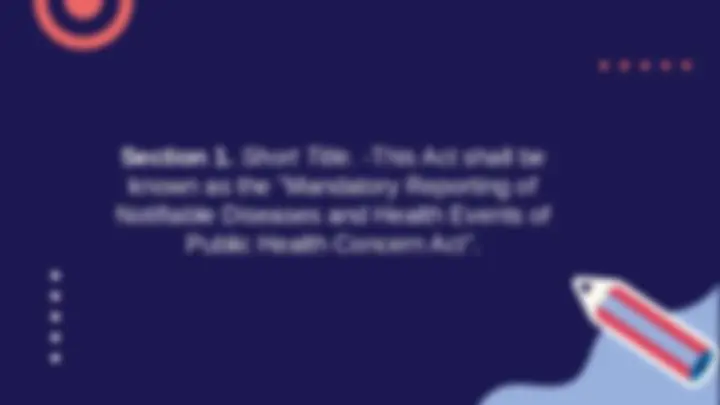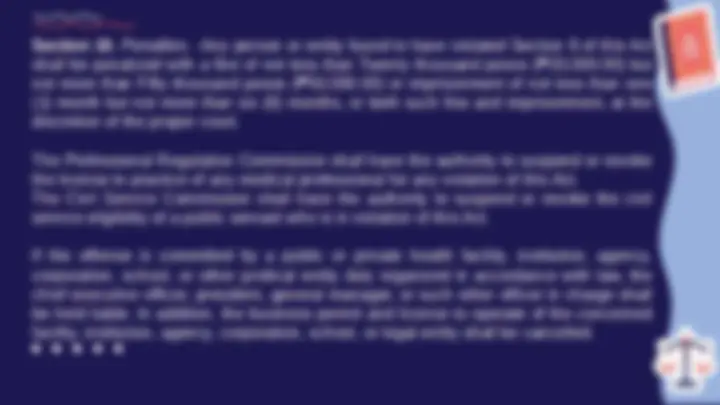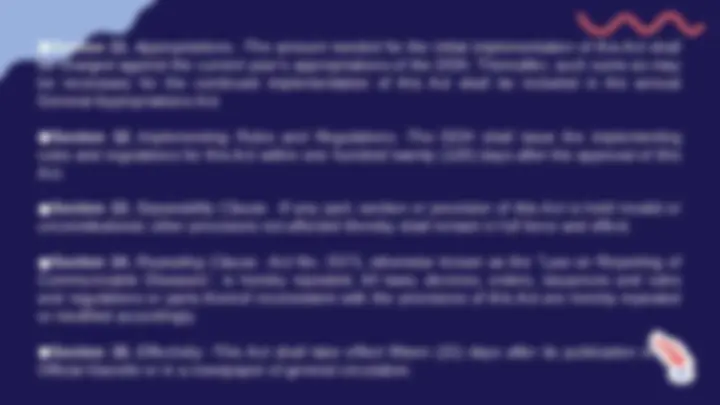















Study with the several resources on Docsity

Earn points by helping other students or get them with a premium plan


Prepare for your exams
Study with the several resources on Docsity

Earn points to download
Earn points by helping other students or get them with a premium plan
Community
Ask the community for help and clear up your study doubts
Discover the best universities in your country according to Docsity users
Free resources
Download our free guides on studying techniques, anxiety management strategies, and thesis advice from Docsity tutors
The Notifiable Law Reporting PPT
Typology: Cheat Sheet
1 / 21

This page cannot be seen from the preview
Don't miss anything!














Section 2. Declaration of Policy. -It is hereby declared the policy of the State to protect and
promote the right to health of the people and instill health consciousness among them. It
shall endeavor to protect the people from public health threats through the efficient and
effective disease surveillance of notifiable diseases including emerging and re-emerging
infectious diseases, diseases for elimination and eradication, epidemics, and health events
including chemical, radio-nuclear and environmental agents of public health concern and
provide an effective response system in compliance with the 2005 International Health
Regulations (IHR) of the World Health Organization (WHO). The State recognizes
epidemics and other public health emergencies as threats to public health and national
security, which can undermine the social, economic, and political functions of the State.
The State also recognizes disease surveillance and response systems of the Department of
Health (DOH) and its local counterparts, as the first line of defense to epidemics and health
events of public health concern that pose risk to public health and security.
Section 3. Definition of Terms. -As used in this Act:
(a) Disease refers to an illness due to a specific toxic substance, occupational exposure or
infectious agent, which affects a susceptible individual, either directly or indirectly, as
from an infected animal or person, or indirectly through an intermediate host, vector, or
the environment;
(b) Disease control refers to the reduction of disease incidence, prevalence, morbidity or
mortality to a locally acceptable level as a result of deliberate efforts and continued
intervention measures to maintain the reduction:
(c) Disease surveillance refers to the ongoing systematic collection, analysis, interpretation,
and dissemination of outcome-specific data for use in the planning, implementation,
and evaluation of public health practice. A disease surveillance system includes the
functional capacity for data analysis as well as the timely dissemination of these data
to persons who can undertake effective prevention and control activities;
(d) Emerging or re-emerging infectious diseases refer to diseases that: (1) have not
occurred in humans before; (2) have occurred previously but affected only small
numbers of people in isolated areas; (3) have occurred throughout human history but
have only recently been recognized as a distant disease due to an infectious agent;
(4) are caused by previously undetected or unknown infectious agents; (5) are due to
mutant or resistant strains of a causative organism; and (6) once were major health
problems in the country, and then declined dramatically, but are again becoming
health problems for a significant proportion of the population:
(l) Public health emergency refers to an occurrence or imminent threat of an
illness or health condition that:
(1) Is caused by any of the following:
(i) Bio terrorism;
(ii) Appearance of a novel or previously controlled or eradicated infectious
agent or biological toxin;
(iii) A natural disaster;
(iv) A chemical attack or accidental release;
(v) A nuclear attack or accident; or
(vi) An attack or accidental release of radioactive materials; and
(2) Poses a high probability of any of the following:
(i) A large number of deaths in the affected population;
(ii) A large number of serious injuries or long-term disabilities in the affected
population;
(iii) Widespread exposure to an infectious or toxic agent that poses a significant
risk of substantial harm to a large number of people in the affected population;
(iv) International exposure to an infectious or toxic agent that poses a
significant risk to the health of citizens of other countries; or
(f) To ensure that public health authorities have the statutory and regulatory authority to ensure
the following:
(1) Mandatory reporting of reportable diseases and health events of public health concern;
(2) Epidemic/outbreaks and/or epidemiologic investigation, case investigations, patient
interviews, review of medical records, contact tracing, specimen collection and testing, risk
assessments, laboratory investigation, population surveys, and environmental investigation;
(3) Quarantine and isolation; and
(4) Rapid containment and implementation of measures for disease prevention and control;
(g) To provide sufficient funding to support operations needed to establish and maintain
epidemiology and surveillance units at the DOH, health facilities and local government units
(LGUs); efficiently and effectively investigate outbreaks and health events of public health
concern; validate, collect, analyze and disseminate disease surveillance information to relevant
agencies or organizations; and implement appropriate response;
(h) To require public and private physicians, allied medical personnel, professional societies,
hospitals, clinics, health facilities, laboratories, pharmaceutical companies, private companies
and institutions, workplaces, schools, prisons, ports, airports, establishments, communities,
other government agencies, and nongovernment organizations (NGOs) to actively participate
in disease surveillance and response; and
(i) To respect to the fullest extent possible, the rights of people to liberty, bodily integrity, and
privacy while maintaining and preserving public health and security.
Section 5. Notifiable Diseases and Health
Events of Public Health Concern. -The
Epidemiology Bureau under the DOH shall
regularly update and issue a list of nationally
notifiable diseases and health events of
public health concern with their corresponding
case definitions. The selection and the
deletion of diseases and health events of
public health concern shall be based on
criteria established by the DOH.
Under this Act:
(a) The DOH and its local counterparts are mandated to implement the mandatory
reporting of notifiable diseases and health events of public health concern;
(b) The DOH and its local counterparts shall establish and maintain functional
disease surveillance and response systems, which include coordination
mechanisms, implementation protocols for reporting and response, measures for
data security and confidentiality, and procedures and provision to ensure safety of
personnel conducting disease surveillance and response activities;
(c) All public and private physicians, allied medical personnel, professional
societies, hospitals, clinics, health facilities, laboratories, institutions, workplaces,
schools, prisons, ports, airports, establishments, communities, other government
agencies, and NGOs are required to accurately and immediately report notifiable
diseases and health events of public health concern as issued by the DOH;
(d) Data collection, analysis, and the dissemination of information from official disease
surveillance and response systems can only be done by authorized personnel from the DOH
and its local counterparts and may only be used for public health concern purposes only;
thus, should be exempted in the provision of Data Privacy Act on accessibility of data;
(e) To perform their disease surveillance and response functions, authorized health personnel
from the DOH and its local counterparts have the statutory and regulatory authority to enforce
the following:
(1) Establishment of public health information system disease surveillance and response
systems in private and public facilities deemed necessary to protect the health of the
population in coordination with the DOH-Epidemiology Bureau;
(2) Mandatory reporting of notifiable diseases and health events of public health concern;
(3) Conduct of epidemic/outbreak and epidemiologic investigations, case investigations,
patient interviews, review of medical records, contact tracing, collection, storage, transport
and testing of samples and specimen, risk assessments, laboratory investigation, population
surveys, and environmental investigation;
Section 8. Establishment of Epidemiology and. Surveillance Units. -The
DOH, in coordination with the LGUs, shall ensure that the Epidemiology and
Surveillance Units (ESUs) are established and functional in all levels of the
DOH and its local counterparts, and in public and private health facilities and
laboratories, as well as ports and airports in ah provinces, cities and
municipalities throughout the country. The ESU shall capture and verify all
reported notifiable diseases and health events of public health concern;
provide timely, accurate, and reliable epidemiologic information to
appropriate agencies; conduct disease surveillance and response activities;
coordinate needed response; and facilitate capacity building in the field of
epidemiology, disease surveillance and response at the Epidemiology
Bureau.
All ESUs shall have trained required human resource complement and
provision of adequate resources, including equipment, logistics,
communication, transportation, laboratory supplies and reagents, personal
protective equipment and health insurance, to effectively perform their
disease surveillance and response functions.
Section 10. Penalties. -Any person or entity found to have violated Section 9 of this Act
shall be penalized with a fine of not less than Twenty thousand pesos (₱20,000.00) but
not more than Fifty thousand pesos (₱50,000.00) or imprisonment of not less than one
(1) month but not more than six (6) months, or both such fine and imprisonment, at the
discretion of the proper court.
The Professional Regulation Commission shall have the authority to suspend or revoke
the license to practice of any medical professional for any violation of this Act.
The Civil Service Commission shall have the authority to suspend or revoke the civil
service eligibility of a public servant who is in violation of this Act.
If the offense is committed by a public or private health facility, institution, agency,
corporation, school, or other juridical entity duly organized in accordance with law, the
chief executive officer, president, general manager, or such other officer in charge shall
be held liable. In addition, the business permit and license to operate of the concerned
facility, institution, agency, corporation, school, or legal entity shall be cancelled.
● Section 11. Appropriations. -The amount needed for the initial implementation of this Act shall
be charged against the current year’s appropriations of the DOH. Thereafter, such sums as may
be necessary for the continued implementation of this Act shall be included in the annual
General Appropriations Act.
● Section 12. Implementing Rules and Regulations. -The DOH shall issue the implementing
rules and regulations for this Act within one hundred twenty (120) days after the approval of this
Act.
● Section 13. Separability Clause. -If any part, section or provision of this Act is held invalid or
unconstitutional, other provisions not affected thereby shall remain in full force and effect.
● Section 14. Repealing Clause. -Act No. 3573, otherwise known as the "Law on Reporting of
Communicable Diseases", is hereby repealed. All laws, decrees, orders, issuances and rules
and regulations or parts thereof inconsistent with the provisions of this Act are hereby repealed
or modified accordingly.
● Section 15. Effectivity. -This Act shall take effect fifteen (15) days after its publication in the
Official Gazette or in a newspaper of general circulation.